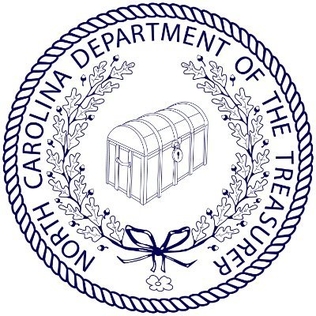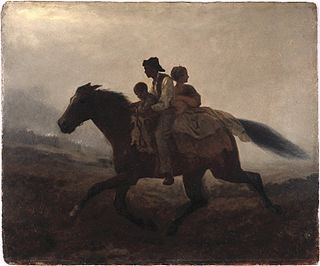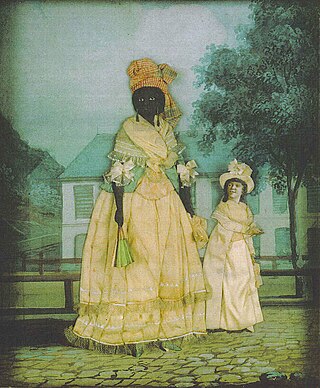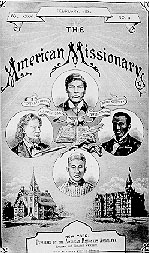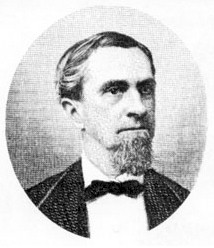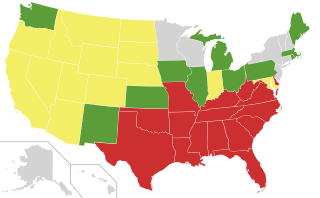The following is a list of court cases in the United States concerning slavery.
| Date | Case | Court | Ruling |
|---|---|---|---|
| 1779 | Brakkee v. Lovell | Vermont Superior Court | Pompey Brakkee had been held as a slave by Elijah Lovell after slavery was made illegal in Vermont. Lovell failed to appear and Brakkee was awarded 400 pounds sterling. [1] |
| 1781 | Brom and Bett v. Ashley | Berkshire County Court of Common Pleas | Slaves Brom and Bett (Elizabeth Freeman) were freed on the basis that the Massachusetts constitution provided that "all men are born free and equal." This case was a precedent for the following one. |
| 1781 | Quock Walker v. Jennison | Worcester County Court of Common Pleas | Jennison's slave, Quock Walker, was found to be a freedman on the basis that slavery was contrary to the Bible and the Massachusetts Constitution. |
| 1783 | Commonwealth v. Jennison | Massachusetts Supreme Judicial Court | Justice William Cushing instructs jury that "slavery is in my judgment as effectively abolished as it can be by the granting of rights and privileges wholly incompatible and repugnant to its existence." [2] |
| 1792 | Guardian of Sally v. Beatty | Supreme Court of South Carolina | A slave owned by Beatty had bought a slave girl Sally and manumitted her. Chief Justice John Rutledge instructed the jury that such an act of generosity on Sally's behalf should not be overturned. |
| 1806 | Hudgins v. Wright | Virginia Supreme Court | Jackey Wright and her two children were freed based on her claim of maternal descent from Native American women. Indian slavery had been prohibited in Virginia since 1705. |
| 1818 | Harry v. Decker & Hopkins | Supreme Court of Mississippi | Decker's slave Harry was freed, and slaves residing in the Northwest Territory become free as per the Ordinance of 1787, and may assert their rights in court. |
| 1820 | Polly v. Lasselle | Supreme Court of Indiana | Indiana gave freedom to blacks in the state who had been held as slaves in the territory prior to Indiana's state constitutional ban on slavery. |
| 1830 | North Carolina v. Mann | Supreme Court of North Carolina | Slaveowners were ruled to have absolute authority over their slaves and could not be found guilty of committing violence against them. |
| 1834 | Rachel v. Walker | Supreme Court of Missouri | A freedom suit of Rachel, a slave who sued for freedom from John Walker in the Supreme Court of Missouri, and won based on his having held her in the free state of Illinois. |
| 1834 | North Carolina v. Negro Will | Supreme Court of North Carolina | Judge William Gaston held that slaves who killed their owner or overseer in self-defense could not be found guilty of murder, but at most manslaughter (cf. North Carolina v. Mann (1830) above) [3] [4] |
| 1836 | Commonwealth v. Aves | Massachusetts Supreme Judicial Court | A slave named Med was freed on the grounds that any slave brought to a free state by his or her owner was thereby set free. |
| 1838 | Hinds v. Brazealle | Supreme Court of Mississippi | Denied a deed of manumission in Ohio for a citizen of Mississippi's mixed-race son and his slave mother, because it was against Mississippi statutes (which required an act by the state legislature), and was considered fraud |
| 1838 | North Carolina v. Manuel | Supreme Court of North Carolina | Judge William Gaston held that free blacks, including former slaves, were citizens of North Carolina and could not be denied any rights guaranteed under the state constitution, including that of declaring insolvency to avoid imprisonment or forced labor for debt. [5] (The decision was cited in Justice Benjamin Curtis's dissent in Dred Scott, below.) [4] |
| 1841 | United States v. Libellants and Claimants of the Schooner Amistad | Supreme Court of the United States | As the Africans in question were never legal property, they were not criminals and had rightfully defended themselves in mutiny. They were unlawfully kidnapped, and the Court directed the President to transport them in return to Africa. |
| 1842 | Prigg v. Pennsylvania | Supreme Court of the United States | Overturned the conviction of slavecatcher Edward Prigg in Pennsylvania based on the ruling that Federal law (which provides for recovery of fugitive slaves) supersedes State law. |
| 1851 | Strader v. Graham | Supreme Court of the United States | The status of three slaves who traveled from Kentucky to the free states of Indiana and Ohio depended on Kentucky slave law rather than Ohio law, which had abolished slavery. |
| 1852 | Lemmon v. New York | Superior Court of the City of New York | Granted freedom to slaves who were brought into New York by their Virginia slave owners, while in transit to Texas. |
| 1853 | Northup v. Epps | – | Recognized that Solomon Northup, who had been abducted from New York and sold as a slave in Louisiana, was free. |
| 1853 | Holmes v. Ford | Oregon Territorial Supreme Court | Granted freedom to a family of slaves who had been brought to Oregon with their master from Missouri, as this action violated the Organic Laws of Oregon, which did not allow slavery. |
| 1857 | Dred Scott v. Sandford | Supreme Court of the United States | People of African descent imported into the United States and held as slaves, or their descendants –whether or not they were slaves –were not included under the Constitution and could never be citizens of the United States. |
| 1859 | Ableman v. Booth | Supreme Court of the United States | Held that state courts cannot issue rulings that contradict the decisions of federal courts, in this case overturning the unconstitutionality ruling by the Wisconsin Supreme Court of the Fugitive Slave Law of 1850. |
| 1985 | United States vs. Sante Kimes | U.S. District Court | Charged with "conspiracy to violate slavery laws" after offering to employ illegal immigrants and then keeping them as prisoners after Kimes was unwilling or unable to pau them. Kimes was sentenced to five years in prison for violating federal anti-slavery laws |
| 2021 | Nestlé USA, Inc. v. Doe | Supreme Court of the United States | Held that respondents improperly sought extraterritorial application of the Alien Tort Statute, as the petitioner's domestic conduct –investing in and doing business with plantations which employ child slave labor –constituted general corporate activity, and conduct which directly caused injury occurred outside of the United States. |




